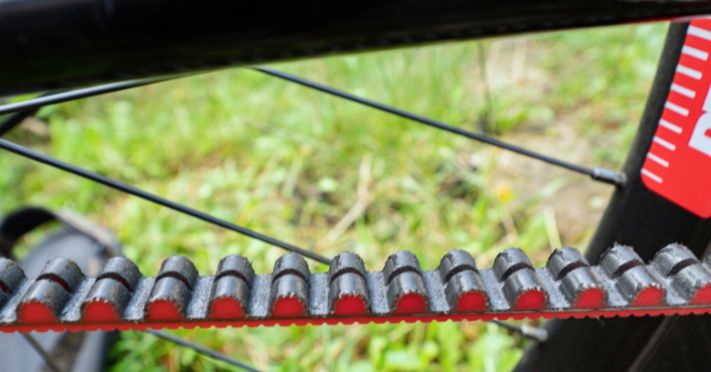Electric bicycles are becoming increasingly more sophisticated, as highlighted by the rise of belt drive technology in both affordable and top-of-the-range models. These e-bike belt drive systems are quickly replacing the messy, greasy metal chains and becoming the new norm. But are they actually better?
We’ll explore how these modern e-bike technologies work and whether chain vs. belt drive e-bikes best suit your riding requirements.
What is a Belt Drive?
An e-bike belt drive system serves the same purpose as a traditional bike chain. But instead of a chain, a toothed belt propels the rear wheel, providing increased durability and minimal maintenance.
Fundamentals of the Belt Drive System
Belt drive systems feature a carbon fiber belt with nylon teeth that wraps around the front chainring and rear cog. This high-quality, lightweight material ensures minimal cleaning and maintenance requirements so you can spend more time enjoying your e-bike — not fixing it.
Plus, this sophisticated belt drive design incorporates the same technology as motor racing engines and motorcycles. The result is a clean, long-lasting, and durable drive system.
Belt Drive vs. Chain Drive: A Quick Comparison
The traditional drive system features a chain connected to the bike’s rear wheel. Chains are ideal for shifting gears and managing tension, which makes them suitable for a derailleur system.
However, the nature of metal chains means they require plenty of maintenance and lubrication. They’re also liable to rust, falling off, and potentially connect with the rider’s legs.
Belt drives, on the other hand, offer a generally more sophisticated system with less maintenance. But there are certainly some drawbacks to consider, like price and available parts.
Advantages of Belt Drives on E-Bikes
E-bike belt drives are generally considered a premium option because of their cost-effectiveness and reduced maintenance. But those are just two of the many advantages.
Longevity and Durability
Belt drive systems typically feature higher-quality construction and materials, ensuring they last longer than most chains. For example, manufacturer Gates Carbon Drive tested both e-bike-specific chains and its CDX CenterTrack belt drive. The latter lasted over 10,000 miles, well beyond the chain’s maximum 275 miles.
Low Maintenance Requirements
As mentioned above, the belt drive’s lack of required maintenance offers a significant advantage. Unlike chain systems that need frequent oil or lubricant application, belt drives continue performing well with minimal care.
Cleanliness
Belt drives attract very little dirt and grime during your riding sessions. As a result, your e-bike generally remains cleaner and requires less routine washing. You can usually commute to work safely, knowing that you won’t arrive dabbed in grease and muck. That said, if you ride through dirty water or thick mud, it’s still a good idea to clean and dry it off.
Quiet Operation and Smooth Ride
A high-performance belt drive enhances your riding experience. Repeated use can make chains loud and clunky, but belt drives offer a smooth and silent ride at all times.
Drawbacks to Consider
Despite these positives, there are some potential disadvantages that you need to consider before purchasing an e-bike with a belt drive.
Initial Costs
Perhaps the most significant issue with a belt drive e-bike is the initial cost compared to traditional chain drive e-bikes. This upfront expense has deterred some riders from buying belt drives and impacted accessibility. However, as belt drives become more common, the prices are dropping, so this is becoming less of an issue.
Lack of Compatibility
Belt drive systems are incompatible with derailleur systems, as the belt can’t run at an angle. This limits drivetrain options and means belt drives can work on single-speed e-bikes or those with an internal gear hub.
Maintenance Challenges
Despite the limited maintenance with belt drive systems, they aren’t completely flawless. You can face issues that require specialized expertise and tools due to the belt drive’s complexity. For example, not all bike frames fit with every belt drive system. That means your e-bike might require a specific design and a specific level of tension to perform optimally.
Replacement Parts Availability
Even with their rising popularity, belt drive systems remain less common than traditional chain systems. Finding spare or replacement parts is challenging, as is getting professional assistance — especially if your local bike shop mechanic isn’t accustomed to belt drives. On top of that, few manufacturers develop belt drive systems. And those that do tend to be proprietary, limiting your options.
Are Belt Drives Right for You?
Ultimately, the decision about buying a belt drive or chain system depends on your preference and riding habits. Belt drives are now available for all sorts of models, enabling mountain e-bikers and off-riders to reap the benefits of the technology. That said, riders in excessive climates may discover some challenges.
Just keep in mind that belt drive systems usually come with a higher initial cost, and replacement parts are less common. The long-term cost benefits and increased durability might outweigh these drawbacks, though.
No matter which drive system you choose, expect to see more e-bikes with a belt drive. Their greater efficiency and lower maintenance are making them more desirable to e-bike riders, especially as the technology continually improves.



